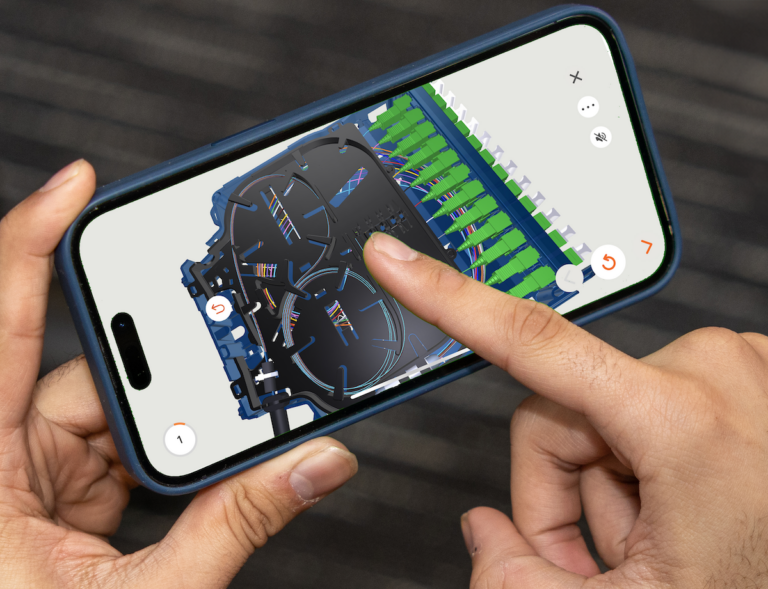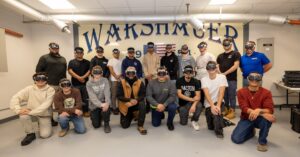Professionals in the skilled trades industry create the infrastructure that supports our neighborhoods and cities. Yet, growing challenges and a dwindling workforce threaten to undermine the efforts of businesses struggling to get ahead. To meet industry challenges, companies need a way to achieve more with fewer workers while keeping up with the demands of modern technology.
While new tech is a part of the reason that field service jobs are increasingly complex, advanced instruction technology has the potential to produce efficient and effective learning systems that support today’s fieldwork.
Companies that invest in modern field service technician training can arm their new and experienced employees with immersive instructions that are easily accessible in any situation. With hands-on, technology-driven features like 3D interactive views and animated step-by-step guides available in any situation, users can proactively solve problems on-site while increasing productivity and reducing errors.
Meeting the Challenges of Modern Field Service Technician Training
The field service industry is changing. Today’s products are composed of multifaceted parts integrated into complex configurations. As a result, they demand a greater knowledge base for installation, programming, maintenance, and repairs. At the same time, the industry is plagued by severe skills shortages.
One recent survey notes that ninety-one percent of firms have trouble filling open positions, and 77% say that lack of skills is the number one reason for the difficulty. Unfortunately, the gap is likely to continue to grow, as 40% of people in the skilled trades workforce are over the age of 45 (half of those are over 55), and fewer than 9% of 19- to 24-year-old workers are entering the industry.
To stay ahead of the curve, advancements in technology require field techs to have immediately accessible information on hand at all times to support complex installations, diagnostics, and repairs. All professionals, from apprentices to seasoned specialists, need the tools to confidently address problems in the field on their own.
Static paper instructions fail to meet these needs and leave too much room for confusion, errors, and callbacks. Modern field service technician training demands interactive, multisensory, and comprehensive instructions that are available in all situations and accessible in all environments.
Modernizing Your Field Service Training with Interactive Tech
Numerous challenges can affect productivity in a given industry, and finding adequate training solutions can seem overwhelming. Businesses must be able to attract and engage new employees and meet the upskilling requirements of experienced professionals. Luckily, the right training materials can simultaneously target multiple challenges at once.
Related: How to Upskill Your Technicians for Today’s Field Service Landscape
These six tips can help you modernize your field service technician training to meet the needs of your employees at all points in their careers.
Tip #1: Engage Learners with Interactive 3D Training Modules
Training is only useful when learners have enough interest to take in the material. The old adage “in one ear and out the other” doesn’t only apply to uninteresting conversations. When training materials are dry and boring, learners can fail to engage even when they want to succeed. While 59% of employees believe that more training improves their performance, 41% of employees say that boring and repetitive courses prevent them from effectively learning more.
Whether they’re used in training or for on-site reference, static paper instructions are limited in their ability to engage learners. Conversely, 3D interactive training modules use innovative technology to provide clear instructions for new processes and products and infrequently performed jobs.
The best platforms provide interactive features that allow users to fully control 360° views and access exploded view diagrams for engaging and personalized learning experiences. When combined with optional features like guided instructions, they engage learners in a variety of ways.

Tip #2: Improve Efficiency with Real-Time Guided Training Sessions
For the best return on investment (ROI), training sessions should be efficient and effective. Time-consuming classroom lecture-style training modules require more sessions and keep employees out of the field for longer periods of time. This can become even more costly when upskilling a digital workforce by delaying experienced employees from getting back out into the field.
Real-time guided training sessions, accessible from a digital app, enable field workers to access clear instructions while working on-site. With features like immersive 3D imagery and targeted search, such platforms enable trainees to pinpoint the instruction they need efficiently and take advantage of the speed of visual learning.
By putting learning tools in the hands of workers, you allow individuals to learn at their own pace—while reducing time-consuming tasks like technical support calls and manual searching. As a result, effective training can be completed in less time than is required by traditional methods.
Tip #3: Mimic Real Life with Hands-on Simulations
While written words, spoken instructions, and static diagrams are often used in various areas of instruction, hands-on learning is best suited for tactile projects like skilled trades. Mentorship programs are one way to enable new employees to get hands-on experience while gaining instruction from an experienced professional. However, this option isn’t always feasible when companies are struggling to fill empty roles.
Interactive digital work instructions can give field workers the opportunity to simulate real situations with the use of interactive 3D images. The right software allows users to pinch, zoom, rotate, and maneuver entire images, individual parts, or specific steps to virtually interact with the same equipment they’ll use in the field. This interactive experience gives learners control over their environment to get a better understanding of products and processes.
Tip #4: Meet Varied Needs with Personalized Learning Paths
Most people are familiar with the idea that individuals respond to different learning strategies and gain full mastery of subjects at different speeds. Yet, traditional learning methods rarely have the flexibility to effectively offer multiple options. Paper materials may include diagrams and infographics and be accompanied by a video demonstration. However, these options don’t allow hands-on learning and don’t put learners in control.
The right digital work instruction software, on the other hand, provides comprehensive 3D visuals accompanied by a choice of optional animated or text instructions that allow learners to use the features that work best with their learning style. The selection allows learners to mix and match features in a way that gives them the optimal combination of information. Kinesthetic learners can add hands-on learning to the mix for a truly interactive multisensory experience.
Tip #5: Promote Continuous Learning with Accurate and Consistent Updates
To remain competitive, businesses constantly innovate and deploy new technology. Field service technician training materials must be updated periodically to keep up with such changes and provide accurate information. Creating frequent reprints of static paper instructions can get costly. Even worse, when updates aren’t completed in a timely manner, resulting errors can lead to dissatisfied customers and repairs that are substantially more expensive.
Related: 4 Ways BILT Improves Job Training—From Apprentices to Certified Pros
Outdated work instructions force field technicians to complete tasks with less accuracy. As you can imagine, this “working in the dark” approach often leads to lower productivity and increased errors. Digital work instruction software enables businesses to submit real-time revisions to provide the most accurate and up-to-date information, quickly and efficiently. When field techs can seamlessly access this information from their preferred mobile device, they can gain confidence that they’re always working with accurate data.
Tip #6: Provide Offline Access for Remote Learning
Working on-site generally requires professionals to rely on learned information or travel with documents to use as a reference. Unfortunately, memory isn’t foolproof, especially when rapidly changing technology often introduces new variables.
When paper instructions are lost or damaged on the field, technicians have no backup materials and must reschedule the appointment or call for assistance. Inaccurate data entry due to a simple error could lead to even bigger problems and costly repairs. Both situations can lead to client dissatisfaction, which can impact loyalty.
With the right platform, users can use devices they always have on hand, whether they have internet access or not, to download interactive training guides and ensure comprehensive, up-to-date instructions are accessible in any environment.
The ability to work from nearly any device—devices users are already familiar with—further improves convenience and safety by enabling workers to access relevant information anywhere. For example, a smartphone will be easier to use than a full-size laptop when perched on a ladder or working in a cramped space.
When employees can always access relevant and up-to-date information, they can confidently interact with clients, promoting transparency and encouraging long-term loyalty.
Implement Field Training with 3D Instructions for the Next Generation of Technicians
High-quality onboarding and upskilling programs can improve recruiting and retention efforts and better support employees who work in the field. As technology evolves, instructions need to advance with it. By modernizing field training, you can eliminate the confusion and errors caused by static paper instructions and engage a new generation of workers.
As an industry leader in the production of digital work instructions, BILT can transform paper manuals and manufacturer’s CAD files into immersive 3D instructions that are ideal for onboarding and ongoing use in the field. Learn more about how we can help you modernize your field service technician training to meet the needs of today’s on-site workers.



